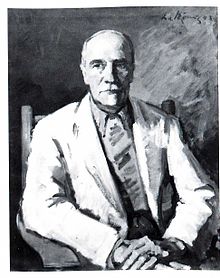Emil Waldmann (art historian)

Emil Waldmann (born December 15, 1880 in Bremen , † March 17, 1945 in Würzburg ) was a German art historian and director of the Kunsthalle Bremen .
biography
Waldmann was the son of a glove shop owner. He studied at the Ruprecht-Karls-University of Heidelberg , the State Academy of Fine Arts in Berlin and the Georg-August-University of Goettingen art history , history and classical archeology and in 1905 with the theme spears, poles and flags as a tool of the composition in the early graphic works of Albrecht Dürer with Robert Vischer (1847–1933) did his doctorate there. In the Kunsthalle Bremen , headed by Gustav Pauli , he became assistant director in 1907 after working for a year as a research assistant. After stays in Italy and Paris from 1910 to 1913, he briefly became director of the Dresden Kupferstichkabinett (1913/14). After Pauli moved to the Hamburger Kunsthalle on July 1, 1914, he returned to his hometown of Bremen as director of the Kunsthalle. During the first years of his activity he was able to systematically add to the collection of German Impressionists despite the difficult economic situation caused by the war. He was able to acquire works by Liebermann , the large self-portrait and the Wannsee Garden, Lovis Corinth's Reclining Nude and the portrait of the painter Bernt Grönvold , as well as seven paintings by Max Slevogt . Waldmann was a supporting member of the SS , a member of the Reichsbund der Deutschen Officials , the Reichsschrifttumskammer , the Reichsluftschutzbund and the NS-Volkswohlfahrt , but not a member of the NSDAP .
Towards the end of the Second World War, Waldmann stayed in Würzburg and tried to commit suicide there with his wife during the heavy bombing raids in the Main.
Key points of his work
Waldmann's focus was on expanding the collection of masters from the 19th century , but he also took the collection further into the modern era . One of his most important publications is the monograph on the etchings and copperplate engravings by Albrecht Altdorfer , and , similar to Gustav Pauli, he was particularly interested in old German prints .
Thanks to successful foundation work, he managed to acquire a family portrait from the hand of Nicolas de Largillière from the estate of Wilhelm Albers and a flower still life by Gustave Courbet from the patron Carl Schütte for the Kunsthalle. The gallery association made it possible for Caspar David Friedrich to acquire the cemetery entrance . From the estate of the Dresden art collector Friedrich Lahmann (1858-1937), the Kunsthalle was awarded in 1937 639 drawings, 3627 sheet printing graphics and 45 paintings, mainly Romantic works, including paintings by Carl Blechen , Carl Gustav Carus , Dahl , Christian Friedrich Gille and by Alfred Sisley .
Waldmann, who was a successful art writer, lecturer and exhibition organizer and thus worked beyond Bremen, was appointed professor by the Senate in 1930. He had a lucky hand with new acquisitions for the Kunsthalle and was open to modern trends. In the time of National Socialism he helped as a “conformist” to separate out some works as “ degenerate art ”, went on a shopping trip to the occupied Netherlands as an art expert, was “appointed as an expert to appraise art from Jewish property” and was allegedly non-political “Loyal to the end of the world” to the National Socialist regime.
After a study trip to the Greek National Gallery in 1912, Emil Waldmann contributed to the rediscovery of the French still life painter Jacques Linard with his article The Athenian Picture Gallery .
Honors
- In the 1920s he was appointed professor by Bremen.
- In Bremen, Emil-Waldmann-Strasse was named after him.
literature
- Kai Artinger: Loyal until the end. Professor Dr. Emil Waldmann (1880–1945): art historian, museum director, university lecturer. In: Ruth Heftrig, Olaf Peters, Barbara Schellewald (eds.): Art history in the “Third Reich”. Theories, methods, practices. Akademie-Verlag, Berlin 2008, ISBN 978-3-05-004448-4 , pp. 134–155.
- Herbert Black Forest : The Great Bremen Lexicon . 2nd, updated, revised and expanded edition. Edition Temmen, Bremen 2003, ISBN 3-86108-693-X .
- Verena Borgmann: The collection and exhibition activities of the Kunsthalle Bremen under Emil Waldmann 1914-1932. In: Kurt Dröge (Ed.): Museum revisited: transdisciplinary perspectives on an institution in transition . Bielefeld: Transcript, 2010, ISBN 978-3-8394-1377-7 , pp. 119-132.
- Kai Artinger: The Kunsthalle Bremen in the Third Reich , Saarbrücken 2010, passim, esp. Pp. 88–118.
Web links
- Literature by and about Emil Waldmann in the catalog of the German National Library
- Emil Waldmann on the website of the Kunsthalle Bremen
Individual evidence
- ↑ As Studies on German Art History 1906 published in ( online ).
- ^ A b Kai Artinger: Loyal to the end. Professor Dr. Emil Waldmann (1880–1945): art historian, museum director, university lecturer. In: Ruth Heftrig, Olaf Peters , Barbara Schellewald (eds.): Art history in the “Third Reich”. Theories, methods, practices. Akademie-Verlag, Berlin 2008, ISBN 978-3-05-004448-4 , pp. 134–155, here p. 144 ( online ).
- ↑ Zeitschrift für bildende Kunst, Volume 23, January 1912, pp. 96–97 together with a reproduction of the painting plums and pears on a pewter plate .
| personal data | |
|---|---|
| SURNAME | Waldmann, Emil |
| BRIEF DESCRIPTION | German art historian and museum director in Bremen |
| DATE OF BIRTH | December 15, 1880 |
| PLACE OF BIRTH | Bremen |
| DATE OF DEATH | March 17, 1945 |
| Place of death | Wurzburg |